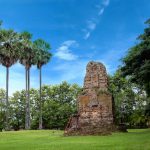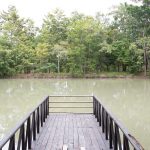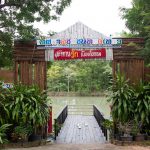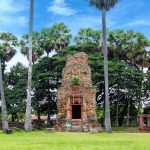Prasat Phum Pon










Prasat Phum Pon
Location : Ban Phum Pon Village, Dom Sub-district, Sangkha District, Surin
Opening time : Everyday (no admission fee)
Website : www.finearts.go.th/surinmuseum
The name of Prasat Phum Pon is assumed to come from the Khmer language with “Phum” meaning land or place and the word “Poon” which is pronounced “Pon” meaning hiding, therefore meaning “hiding place”. This would relate to local lore concerning this temple referring to “Niang Dor Thom” meaning “big breast woman” who was the daughter of a King brought to live here in safety from war.
Prasat Phum Pon is a religious site of the Hindu faith. The construction was done in 2 periods; the first period being in the 12th – 13th Buddhist century and is the oldest Chenla (550-706 A.D.) edifice in Thailand. Excavations also revealed parts of a stone inscription in Pallava and second era Sanskrit script. There were further construction but without significant period definition.
Prasat Phum Pon consists of 3 brick buildings, with one building having a laterite base following the north-south line. The architectural elements of the first building period are :
Main chapel : It is in a rather intact condition. The whole building was built with bricks and some sandstone and without mortar as per the norm of ancient Khmer art. The layout is square with a low base and the building is square as well. There is only one entrance on the east face and the roof is layered. There are only 3 buildings left today. The carvings on the gable above the entrance is of curling leaves in the Indian post-Gupta style (11th-13th Buddhist century). One stone inscription in Pallava and Sanskrit was found here during excavations.
The northern most chapel : The building technique and the style is the same as the main chapel but only smaller in size. At present only the base and the doorframe and small portions of walls remain to be seen. Sandstone decorative pillars at the doorframe and a lintel made still remains with carvings of a half lion half bird creature flanking 3 oval rings which probably had carvings of humans but is eroded. These carvings are in the Prei Khmeng style (635-700 A.D.)
The elements of the later building period consist of :
A Small brick chapel : Located in the middle completely collapsed. A crouching sandstone bull statue was found in front of the rubble.
A laterite base which the building is completely collapsed.
Also, 500 meters away at the northeastern side of the complex, a Baray style pond was found. It is rectangle in the ancient Khmer culture style which served as an important irrigation system found in ancient Khmer communities between the 12th- 18th Buddhist century around the northeast of Thailand. A Baray is not a dug pond but uses clay to create a walled enclosure in a low area where a natural stream flows to retain water for the community’s consumption and might have been used to prevent floods as well. Barays are generally larger in size than normal ponds.
Era : From the excavation fragments of a stone inscription in Pallava and Sanskrit script was found which made it possible to estimate that this site dates from the 12th Buddhist century.
